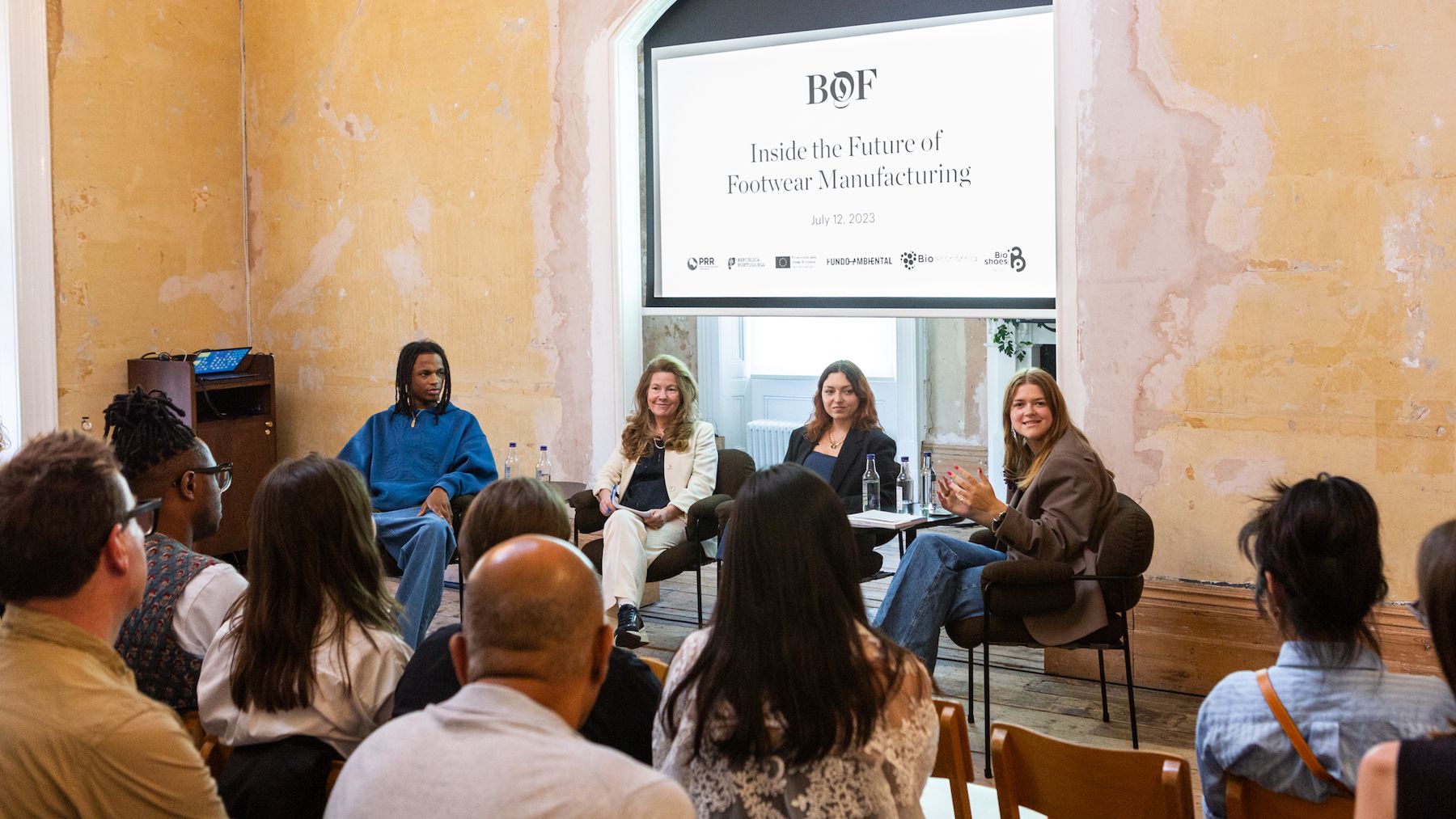
From technological shifts and material innovation to evolving customer interest in design styles and sustainability, the footwear industry is in flux. However, at the crux of its change is the ongoing disruption in the global supply chain, with its fragilities exaggerated by an unpredictable socio-political market.
Consequently, nurturing a close relationship with manufacturers is more critical than ever before. Indeed, BoF and McKinsey & Co.’s State of Fashion 2023 report states that 60 percent of fashion industry executives are considering forming strategic partnerships with their suppliers as pressures continue to weigh on fashion’s global supply chains.
China is currently the world’s largest footwear manufacturer, accounting for 54 percent of total production worldwide, as reported by World Footwear Yearbook. However, the State of Fashion 2023 report found 65 percent of fashion executives are considering nearshoring.
As a result, many Western brands and businesses are looking to create new manufacturing hubs dedicated to serving US and European demand. Through this approach, brands are also seeking to foster deeper relationships with suppliers to facilitate innovation, flexibility, and to increase traceability and transparency to in turn develop greater trust with their end consumer.
One such manufacturing hub poised to serve a growing demand in Europe is Portugal, with a long history in footwear production, a trade which employs some 40,000 people in the country. In 2022, Portuguese footwear reached new production records, reaching €2.3 billion and with exports making up 90 percent of production.
The €2 billion in exports is an increase of 20.2 percent from the previous year, and 12.6 percent growth compared to 2019, according to the Portuguese Footwear Association. While Germany is the largest destination market, followed by France, the Netherlands and Spain, it is the UK where Portugal is making active efforts to fortify and strengthen sector relationships. The US represents 5.7 percent of exports.
Today, Portugal is doubling down on its efforts within the footwear sector. With the support of the European Union and the Portuguese Government, it is investing 140 million euros into its manufacturers, and into the fields of innovation and sustainability.
To better understand the growing opportunities in footwear manufacturing and what it represents in Portugal, BoF and the Portuguese Association of Manufacturers of Footwear, Components, Leather Goods and Substitutes (APICCAPS) co-hosted a panel event in London this July.
Hosted by BoF’s Alice Gividen, panellists included: Marta Indeka, foresight analyst and trend forecaster at The Future Laboratory; Maria José Ferreira, head of research and development at the Portuguese Footwear Research and Technical Centre; and Junior Clint, founder and designer of CLINTS — a Manchester-based brand launched in 2020, which produces its footwear and recently established clothing line in Portugal.
Now, BoF shares key insights from the discussion on the future of footwear manufacturing.
Be transparent and clear to build trust with consumers
MI: There is more of a demand for certifications and labels, for guidance and education, because it’s becoming hard to navigate. Scrutiny is higher and higher on greenwashing. […] To understand all of this, consumers want to be able to clearly understand — at a glance — what you are doing. That trust can only be built with that clarity and communication.
JC: When we go to our factories in Portugal, we document the process and that gives our consumers a glimpse into manufacturing without overcomplicating it. This way, they can really see the process. […] Across the board, it comes down to the customer expectation online in relation to education on the clothes, and it’s hard to do it without being too wordy.
When we go to our factories in Portugal, we document the process and that gives our consumers a glimpse into manufacturing without overcomplicating it.
MJF: Consumers want a product that is more comfortable but also that is from a transparent supply chain. […] We need to show how these things are done and offer consumers a life-cycle analysis. We — the brands, the factories — are collectively responsible for sharing this information. This transparency is how we will measure, diagnose, change and improve our processes and products.
Manage consumer expectation in durability vs sustainable innovation
JC: The main objective for us is durability. From there, we start talking about design. When we started in 2020, sustainability was the buzzword. But a lot of that, at the time, didn’t mean durability. They were focused on fabrications and how they will influence the future of footwear, but when it comes to comfort and durability, people were hesitant to go down that direction.
Durability is a massive thing as you’re competing with the best, so if someone chooses to purchase an item from our website, if they get a product and it’s not to their standard, they won’t buy again.
MI: Some things that have evolved quickly in fashion are a lot of biomaterials, new textiles and a wealth of new raw materials that [brands] can work with and experiment with, and it’s catching up with footwear now. [In fashion], there has been time to mature the idea and to accept [innovative materials] in your mind [and] that you could wear something that seems a little bit [different].
We have started seeing these biodegradable or compostable shoes but there’s always a lot of consumer concerns that you need to overcome before you can put that to market. It’s [questions] like: “Is my shoe going to fall apart after I wear it in the rain after two months?” And you need to do the legwork to prep the market to receive these innovations. There are great supply chain and material innovations just waiting to be deployed.
MJF: Cork is a very durable, renewable material that can be easily recycled but customers are conscious of buying organic materials. However, it’s good for heating and cooling off the shoes […] and now, there is work on this kind of material to combine it with other fibres, to produce other properties with biomaterial resistance.
While we recycle waste in our production sector, we need to be considering how we can [create footwear that can be] dismantled. Is it possible or even logical? Is it sustainable, from an economic and environmental approach, to dismantle?
We are also finding ways to make materials from fine gas, from trees, recycling biodiesel — even paper waste. Consumers want these different materials. We are betting on textiles that are not fossil-based but biological.
Break down sustainable practice to its core design
MI: Because of the nature of shoes, they are meant to be worn down as you use them more intensively. […] Leather shoes, manufactured shoes would be much easier to repair if just one part needed changing. But when you have a shoe that you can’t disassemble because it’s been mass produced, obviously it has to be discarded. You can’t really recycle it either, which poses many issues. I think that fast fashion awareness is starting to extend slowly but steadily to footwear as well.
MJF: The future needs to incorporate circular strategies. While we recycle waste in our production sector, we need to be considering how we can [create footwear that can be] dismantled. Is it possible or even logical? Is it sustainable, from an economic and environmental approach, to dismantle? Design is very important in this process and we can make designs to facilitate this.
Champion an open source approach to manufacturing
MI: Luxury tends to integrate their supply chain. For example, a Bottega Veneta footwear factory just reopened in Italy, taking everything in-house, which for them is great because you can develop and test super quickly. But if you don’t manufacture it in an open source way, it creates more barriers for small and medium enterprises and more barriers in the sector.
In that sense, this is where partnerships and open source models are key. When you are not Bottega Veneta, and you do not have all these resources backing you, how can you have access to that supply chain that’s going to help you achieve what you are trying to do?
If you don’t manufacture it in an open source way, it creates more barriers for small and medium enterprises and more barriers in the sector.
JC: Because of the transition in our manufacturing from China to Portugal, we had to remake a lot of our old models that we had in China — and that’s quite difficult, to remake the same model using different factories.
But [we received] support from our manufacturers in Portugal, in terms of communication and to see where we can push new ideas. These are huge factories, so for them to listen to us — we might not have the same infrastructure [as bigger brands], but the support comes from how intimate our relationship is with the key figures in the factory.
MJF: Today, the manufacturing process is more than just simply [shoe production]. It requires innovating manufacturing processes and responsibly managing excess stock. It requires help with recycling and with the end-of-life of products. This is possible when you have a good dialogue with your manufacturers. As a manufacturing hub, [Portugal] holds all the assets needed to support brands and retailers in realising these steps.
Expect consumers to interrogate each purchase
JC: The main goal for us, as such a small brand, is trust across the board, from factories to the end consumer. A friend of mine, Jack Harper, runs a clothing brand [Aeliza] which has a concept of asking “why”. He encourages the customer to think more about their daily decisions, which does not necessarily have to be about the clothes but about their day-to-day actions and he has built his brand as more of a case study.
Through that, I see a portion of the market moving more towards the “why” rather than sporadic decision-making when it comes to impulse buying. CLINTS has been a part of that conversation because, as a start-up, you need that influence. No matter how great the product is, you are still competing with the biggest brands.
MI: When you look at most consumers, but especially young people, what they love is to know how things are made. They love to develop more of an emotional relationship with their belongings and to look at how it’s crafted. What is the story of the brand? What is the story of that product? To look behind the scenes. You can’t have too much storytelling about that […] when you are vocal about the “why”. This is something that they are receptive to, and there is room to play with that as well.
Streetwear has been slowing down — Supreme drops are not selling out and sneaker sales are slowing down for one of the first times in years. You would have trainers and athleisure, all that side of the sector being like a cash cow and seeing it slow down is a challenge but also an opportunity for brands to tune into what is actually going to replace it and start to gain speed.
This is a sponsored feature paid for by the Portuguese Footwear Association as part of a BoF partnership.



